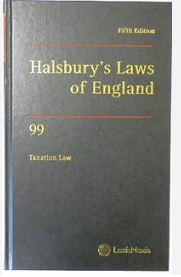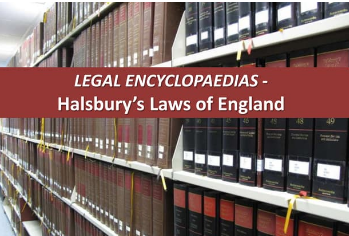
Halsbury’s Laws of England is a legal encyclopedia that provides an authoritative and comprehensive commentary of legal principles, and statutes on the laws of England.
First published in 1907, it is named after its founder, Lord Halsbury, a prominent British politician, and lawyer.
The Halsbury’s Laws of England cover a wide range of legal topics. It is regarded as the definitive source of legal knowledge and is frequently cited in legal literature and court judgments.
Halsbury’s Laws of England is an indispensable resource for legal academics, professionals and students, providing in-depth analysis and commentary on the complexities of English Law. Its authority and reliability have made it an essential reference work in the legal community for over a century.
The encyclopaedic is regularly updated to reflect changes in the England laws, with new editions.
Each edition is carefully revised and reviewed by a team of legal scholars and expert lawyers to ensure accuracy and relevance.
Historical Background:
Halsbury’s laws of England can be traced back to the early 20th century when Halsbury recognized the need for an accessible and cohesive legal reference work.
The edition, published between 1907 and 1917, was a monumental undertaking that aimed to consolidate the vast body of English law into an organized, coherent format. It has evolved through judicial decisions, statutes, and customs.
Some key’s of England law include:
Contract law.
Property law.
Family law.
Criminal law.
Tort law.
Constitution law.

Some more notable features of English law include:
The doctrine of precedent.
The rule of law.
The use of juries in criminal trials.
The distinction between common law and equity.
Structure and content :
Halsbury’s laws of England are structured into many volumes, each covering a distinct area of law. The content is organized to provide a comprehensive and logical treatment of each legal topic. The entire set consists of 50-60 volumes, each focusing on a specific area of law.
Some volume topics include :
1. Volume 1: Courts and legal profession.
2. Volume 2: Contract law .
3. Volume 3: Constitutional and Administrative Law.
4. Volume 4: Criminal law.
5. Volume 5: Conveyancing and Property Law.
6. Volume 6: Copyright, Patents, and Intellectual Property.
7. Volume 7: Debt and Insolvency.
8. Volume 8: Family Law .
9. Volume 9: Employment Law .
10. Volume 10: Criminal Procedure .
1. Subject areas :
The encyclopedic is divided into numerous subject areas, such as Criminal Law, Constitutional Law , Family Law, Property Law, and Contract Law . Each Subject area is further subdivided into some topics offering detailed analysis and explanation.
2. Statutory and Case Law :
Halsbury’s Law integrates statutory provisions and case law, providing an authentic view of the legal landscape.
This integration is essential for understanding how statutes are applied by the courts.
3. Commentary and analysis:
In addition to summarizing the law, Halsbury’s laws offer insightful analysis and commentary from leading legal experts. This commentary helps readers understand the nuances and implications of legal decisions and principles.
4. Cross-Reference and Citations :
The encyclopedic is extensively cross-referenced enabling users to navigate seamlessly between the same or different topics.
Citations to primary sources, including cases, statutes, and secondary materials, are provided to support the text and facilitate further research.

Importance and Impact :
Halsbury’s Law of England is regarded as an indispensable tool for legal professionals.
Its importance can be attributed to several points :
1. Authoritative :
The encyclopedic is authored by eminent legal scholars and practitioners, ensuring that the information is reliable, accurate, and authoritative Courts frequently cite Halsbury’s Laws as a persuasive source of legal authority.
2. Comprehensive:
The breadth and depth of coverage make Halsbury’s Laws a one-stop reference for virtually all aspects of English law.
This comprehensive scope is particularly valuable for practice and legal research, allowing users to find answers to complex legal questions efficiently.
3. Accessibility:
Despite its extensive content, Halsbury’s law is designed to be user-friendly. The clear and concise language, along with logical organization, makes it accessible to both legal professionals and those without formal legal training.
4. Updating Mechanism :
Regular updates ensure that Halsbury’s Laws remain current with the latest and an amazing legal developments. This dynamic updating mechanism is crucial in a constantly evolving legal environment.

Edition and updates :
Halsbury’s laws of England have undergone several updates and revisions . Each new edition incorporates changes in case law, legislation and legal practice. The recent edition, the fifth, was published in 2008, with ongoing updates provided through reissues, cumulative supplements, and an online platform.
1. Cumulative Supplements :
These supplements update the content of the main volumes with recent legal developments, ensuring that users have access to the current information.
2. Reissues :
Entire volumes are periodically reissued to incorporate changes and unique material comprehensively. Reissues are essential for maintaining the integrity smoothly and coherence of the encyclopedia.
3. Online Access :
The advent of digital technology has revolutionized access to legal information more effectively.
Halsbury’s law is available online through platforms , providing users with access to the latest updates and advanced functionalities.





